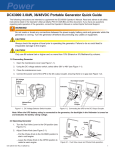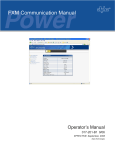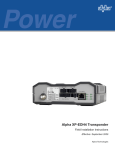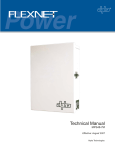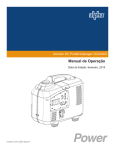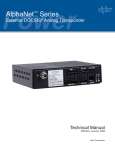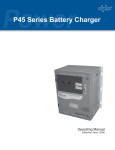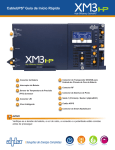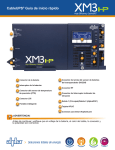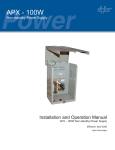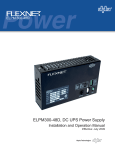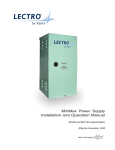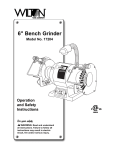Download Alpha Technologies DCX3000 Specifications
Transcript
DCX3000 Portable Generator Operation Manual 3.0kW, 36/48V, DC Portable Generator Effective: September 2006 Alpha Technologies Power Alpha Technologies ® AlphaGen DCX3000 3.0kW, 36/48V DC Portable Generator Operation Manual 041-028-B0-003, Rev. C Effective Date: September 2006 Copyright© 2006 Alpha Technologies, Inc. member of The GroupTM NOTE: Photographs contained in this manual are for illustrative purposes only. These photographs may not match your installation. NOTE: Operator is cautioned to review the drawings and illustrations contained in this manual before proceeding. If there are questions regarding the safe operation of this powering system, please contact Alpha Technologies or your nearest Alpha representative. NOTE: Alpha shall not be held liable for any damage or injury involving its enclosures, power supplies, generators, batteries, or other hardware if used or operated in any manner or subject to any condition not consistent with its intended purpose, or is installed or operated in an unapproved manner, or improperly maintained. Contacting Alpha Technologies: www.alpha.com or For general product information and customer service (7 AM to 5 PM, Pacific Time), call 1-800-863-3930 For complete technical support, call 1-800-863-3364 7 AM to 5 PM, Pacific Time or 24/7 emergency support 3 Table of Contents Safety Notes .......................................................................................................................... 6 1.0 Introduction ................................................................................................................. 8 2.0 Specifications.............................................................................................................. 9 3.0 Battery Cable Connections ....................................................................................... 10 Enclosures with Generator Access Door ....................................................... 10 3.2 Enclosures without Generator Access Door ...................................................11 3.3 Grounding ...................................................................................................... 16 4.0 Starting the Engine ................................................................................................... 18 5.0 Engine Shut-Down and Cable Removal ................................................................... 20 6.0 4 3.1 5.1 Long-term Storage ......................................................................................... 20 5.2 Scheduled Maintenance ................................................................................ 20 5.3 Transporting the Generator ............................................................................ 20 5.4 Fuse Replacement ......................................................................................... 21 Maintenance Record................................................................................................. 22 041-028-B0-003, Rev. C List of Figures Fig. 1-1, DCX3000 Overview ................................................................................................. 8 Fig. 1-2, Basic Block Diagram ............................................................................................... 8 Fig. 3-1, Generator Access Door and Battery Pack Adapter Cable ..................................... 10 Fig. 3-2, Enclosure without Generator Access Door.............................................................11 Fig. 3-3, Alligator Clamp-style Connection .......................................................................... 12 Fig. 3-4, Ring Lug-style Connection .................................................................................... 13 Fig. 3-5, Novus-style Connection ........................................................................................ 14 Fig. 3-6, Y-style Connection................................................................................................ 15 Fig. 3-7, Generator Grounding ............................................................................................ 16 Fig. 3-8, Overview of PWE Installation ................................................................................ 17 Fig. 4-1, Starting the Engine ................................................................................................ 18 Table 4-1, Battery Voltage and Output Indications .............................................................. 19 041-028-B0-003, Rev. C 5 Safety Notes Review the drawings and illustrations contained in this manual before proceeding. If there are any questions regarding the safe installation or operation of this product, contact Alpha Technologies or the nearest Alpha representative. Save this document for future reference. To reduce the risk of injury or death, and to ensure the continued safe operation of this product, the following symbols have been placed throughout this manual. Where these symbols appear, use extra care and attention. ATTENTION: The use of ATTENTION indicates specific regulatory/code requirements that may affect the placement of equipment and /or installation procedures. NOTE: A NOTE provide additional information to help complete a specific task or procedure. CAUTION! The use of CAUTION indicates safety information intended to PREVENT DAMAGE to material or equipment. WARNING! WARNING presents safety information to PREVENT INJURY OR DEATH to the technician or user. 6 041-028-B0-003, Rev. C General Safety Information • The manufacturer cannot anticipate every circumstance that may involve a hazard, therefore, these warnings are not all inclusive. • Do not use the generator or any of its parts as a step. • Generator must be properly grounded. • Do not place or operate the generator in standing water, or expose to a forced spray of water. • Do not make or break any connections while generator is running. • Fuel spillage cleanup is the responsibility of the operator and should comply with local codes and regulations. • Do not refuel the generator while engine is running. Allow generator to cool before refueling. • For fire safety, the generator must be properly connected, maintained, and in compliance with applicable codes and regulations. • Engine exhaust contains carbon monoxide gas, which can be deadly in closed or poorly ventilated areas. • Prior to each use, inspect the generator for leaks and damage. Immediately repair or replace any damaged parts. • Never operate the generator near combustible materials. • Ensure cables do not cross hot surfaces or sharp edges. Inspect cables before and after each use. • Drain oil and empty the fuel tank before transporting. Fuel can leak from the filler cap if the generator is tilted. • Never refuel the generator in the vicinity of open flames of heat sources. Do not smoke near the generator. • The generator should be operated on level ground. If necessary, it may be operated on a grade <15°. • Use only vendor-authorized repair parts. • Do not operate generator unattended. ATTENTION: • Alpha Technologies’ products are subject to change through continual improvement processes. Therefore, specifications and design layouts may vary slightly from descriptions included in this manual. Updates to the manual are issued when changes affect form, fit or function. • This product is manufactured to conform to the Federal Communications Commissions (FCC) Part 15, Class A regulations. It is intended to be used for commercial, industrial or business environments. • This device complies with part 15 of the FCC rules. Operation is subject to the following two conditions: (1) This device may not cause harmful interference, and (2) this device must accept any interference received, including interference that may cause undesired operation. 041-028-B0-003, Rev. C 7 1.0 Introduction The Alphagen DCX3000 portable DC generator supplies DC power to a power node battery bus during AC line interruptions. Upon loss of commercial AC power, the existing battery strings supply the power supply inverters. After some interval of battery discharge, the operator deploys the portable generator at the site to supply power to the DC bus. The generator delivers continuous, high-quality power throughout the commercial AC interruption period. After restoration of commercial AC power, the operator disconnects and removes the generator. 9 1 Status LEDs 2 Engine Switch 3 Choke 1 5 8 4 Fuel Valve 2 5 Voltmeter 6 Output Off Button 7 3 4 6 7 DC Out 8 Pull-start 9 Fuel Tank Fig. 1-1, DCX3000 Overview Engine Alternator Rectifier Load (batteries) DC Sense Feedback Controller Fig. 1-2, Basic Block Diagram 8 041-028-B0-003, Rev. C 2.0 Specifications Engine Honda GX 200 6.5 hp, air-cooled, OHV, single cylinder, manual recoil starting, manual choke Fuel/Fuel Tank Unleaded gasoline/3.5 gallon metal tank with level gauge Rated Power 2800W continuous, 3000W maximum Alternator Permanent magnet, brushless, bearingless Output Voltage Dual range selector 36V: 39.5VDC, nominal at generator output connector 48V: 52.5VDC, nominal at generator output connector Output Regulation +/-1VDC Control Features Automatic Voltage Regulation Electronic Governor Overcurrent Protection Analog voltmeter with back light Cable Interface Anderson type SBE-80 connector Runtime @25% load (48V): 15.4 hours @25% load (36V): 17.5 hours @100% rated load: 6.5 hours Audible Noise Approximately 65dBA @ 7 meters under full load Frame Fully enclosed Dry Weight 117 lb Dimensions 22" H X 17.6" W X 25.9" D (557mm x 447mm x 657mm) Operating Temp 5°F to 104°F (-15°C to 40°C) Required Accessories Output Interface Cable: Available in 10', 30', or 50' lengths Battery Interface Cable: Choose Ring Lug, Heavy-duty Alligator Clamp, or Y-adapter (Connects the power supply’s battery input directly to the generator. See Section 3.0 for more information) Agency Compliance CSA 22.2 No. 100-95 FCC part 15B Class A CARB UL 50, Section 30 NFPA 37, 70 EPA Optional Accessories Portable Generator Wheel Kit: P/N 745-793-20 Punch Tool Kit for Enclosures, 2.5" dia: P/N 745-131-20 Enclosure Upgrade Kit: P/N 745-131-21 Cable Bag and Cable Key Lanyard: P/N 745-764-21 Locking Handle: P/N 745-792-20 NOTE: Please refer to www.alpha.com for available options and data sheets. 041-028-B0-003, Rev. C 9 3.0 Battery Cable Connections 3.1 Enclosures with Generator Access Door Tools and Materials Needed: • Portable Generator Battery Cable Kit • DC Multimeter Procedure: 1. Open the enclosure’s battery compartment and locate the battery pack connections for the positive and negative battery cables leading to the power supply. 2. Observing polarity (red to positive, black to negative), connect the Battery Pack Adapter Cable to the connections located in Step 1. Attach Ring Lug or Alligator Clamp connections directly to the battery post. See Fig. 3-5 and Fig. 3-6 for Novus-style and Ystyle connections. Do not connect the extension cable to the DC OUT jack on the front panel of the generator at this time. 3. Route the extension cable (10’, 30’, or 50’) into the enclosure’s battery compartment. Protect cable from chafing against sharp edges. 4. Connect the Battery Pack Adapter Cable to the extension cable. Extension cables are equipped with in-line fuses. Replace only with 100 Amp 300VAC fuse (Alpha P/N 460191-10). CAUTION! Inspect cable sets before each use for damage and wear. Use only cable sets that are designed for this generator. Fig. 3-1, Generator Access Door and Battery Pack Adapter Cable 10 041-028-B0-003, Rev. C 3.0 Battery Cable Connections, continued 3.2 Enclosures without Generator Access Door Tools and Materials Needed: • 2.5" Punch Tool Kit for Enclosures (Alpha P/N 745-131-20) • 2.5" Enclosure Upgrade Kit (Alpha P/N 745-131-21) • Electric drill • #7 Drill bit (.2010”) or #9 drill bit (.1960”) • #2 Phillips screwdriver WARNING! Disconnect all sources of service power to the enclosure before drilling holes. Ensure the area is clear of wires and electrical boxes. Do not locate the hole above electrical boxes to prevent damage from water intrusion while the plug is removed. Procedure: 1. If not previously installed, punch or cut a 2.5” hole in the enclosure (shown below) to route the generator’s battery cable. Ensure area is clear of electrical wires and boxes. 2. Install the grommet into the hole, and install the weatherproof plug into the grommet. 3. Using the #7 or #9 drill bit, drill a hole approximately 2” below and to one side of the grommet, attach the lanyard on the inside of the enclosure with the #10 bolt and nut provided. Suggested location of battery cable hole for PWE enclosures Hole for lanyard bolt Fig. 3-2, Enclosure without Generator Access Door 041-028-B0-003, Rev. C 11 3.0 Battery Cable Connections, continued 3 Extension Cable Set, 50’ P/N 875-324-21 30’ P/N 875-324-20 10’ P/N 875-324-22 Red 2 Fuse 1 Alligator Clamp-style Battery Pack Adapter Cable, P/N 874-946-20 Black Ensure clamps lay flat against batteries, facing inward Fig. 3-3, Alligator Clamp-style Connection 12 041-028-B0-003, Rev. C 3.0 Battery Cable Connections, continued Extension Cable Set, 50’ P/N 875-324-21 30’ P/N 875-324-20 10’ P/N 875-324-22 3 Red 2 Fuse Ring Lug-style Battery Pack Adapter Cable, P/N 874-946-21 1 Black Cable rings connect directly to the battery terminals Fig. 3-4, Ring Lug-style Connection 041-028-B0-003, Rev. C 13 3.0 Battery Cable Connections, continued Circuit Breaker must be CLOSED OUTPUTS GENERATOR BREAKER CONVENIENCE FROM XT1 UPS BYPAS S EXT GENERATOR LA-P Plus 60A HEATING PADS Novus Power Panel BLACK RED Novus-style Battery Pack Adapter Cable P/N 875-324-23 Extension Cable Set, 50’ P/N 875-324-21 30’ P/N 875-324-20 10’ P/N 875-324-22 Fig. 3-5, Novus-style Connection 14 041-028-B0-003, Rev. C 3.0 Battery Cable Connections, continued Y-style Battery Pack Adapter Cable P/N 874-946-22 Extension Cable Set, 50’ P/N 875-324-21 30’ P/N 875-324-20 10’ P/N 875-324-22 3 2 Fuse 1 Fig. 3-6, Y-style Connection 041-028-B0-003, Rev. C 15 3.0 Battery Cable Connections, continued 3.3 Grounding Tools and Materials Needed: #8AWG copper ground wire and clamps Procedure: 1. Read and thoroughly understand the Engine Owner’s Manual before operating this equipment. 2. Before starting the generator, follow all instructions outlined in the BEFORE OPERATION section of the Engine Owner’s Manual. 3. Attach #8AWG copper grounding wire between the generator grounding lug and the service entrance grounding bar, or directly to the utility grounding rod. WARNING! To prevent injury, the generator must share a common ground with the enclosure service entrance. Generator Grounding Lug Fig. 3-7, Generator Grounding 16 041-028-B0-003, Rev. C 3.0 Battery Cable Connections, continued Ground Wire To prevent injury, the generator MUST share a common ground with the enclosure service entrance. Power Meter Ground Stake Ground Wire Fig. 3-8, Overview of PWE Installation 041-028-B0-003, Rev. C 17 4.0 Starting the Engine Prior to starting the generator, review the Safety Information on page 6 of this manual. Set the generator on a flat, level surface, free of standing or running water, or combustible materials. Operating the generator at an angle of more than 15 degrees may result in the oil level dropping below a safe level. This may cause the low oil sensor to trip, or failure of the generator to shut down. This generator runs very quietly. It is not always possible in ambient-noise situations to determine whether it is running simply by sound. Verify that the generator is OFF before proceeding with the following procedure. Tools and Materials Needed: #2 Flat-tip screwdriver (to open side panel) Procedure: 1. Verify fuel is in the fuel tank. 2. Open the maintenance cover on the left side panel of the generator. Set the Voltage Select switch to match the battery pack voltage (36V or 48V). Close cover before starting engine. Voltage Select Switch 3. Verify polarity and battery voltage continuity on extension cables. Connect the extension cable coupler to the DC OUT jack on the generator. Verify the voltmeter indicates the voltage of the battery pack. NOTE: Set correct voltage on Voltage Select Switch. Generator will not engage with incorrect voltage setting. 4. 5. 6. 7. Insert key and turn the ENGINE SW to the ON position. If the engine is cold, pull the CHOKE knob out. Turn the FUEL VALVE to the ON position. Pull the starter handle (right side panel) until the engine starts. Verify the OUTPUT INDICATOR LED is a steady green (not blinking). If the OUTPUT INDICATOR LED is flashing red, a voltage mis-match has occurred, or the battery pack is excessively discharged. Refer to the voltage table on page 19 for more information. 8. As the engine warms, push the CHOKE knob in. OUTPUT INDICATOR LED (Step 7) DC OUT (Step 3) ENGINE SW (Step 4) FUEL VALVE (Step 6) CHOKE (Steps 5, 8) Fig. 4-1, Starting the Engine 18 041-028-B0-003, Rev. C 4.0 Starting the Engine, continued Battery Voltage 1 0V to 2V 2V to 27V 27V to 42V 42V to 55V >56V Voltage Select Output Indicator (Green LED) Switch Position Overload Alarm (Red LED) Forced Output 2 36V OFF OFF Not Available 48V OFF OFF 36V OFF Not Available ENABLED 48V OFF FLASHING FLASHING 36V 48V ON OFF FLASHING 36V OFF 48V ON 36V OFF OFF 48V OFF ENABLED Not Available ENABLED FLASHING Not Available Not Available Not Available 3 FLASHING Not Available 3 FLASHING OFF 1 All battery voltage measurements are ± 1V 2 To enable forced output when the Overload Alarm LED is flashing, press the output button for at least 5 seconds. The Overload Alarm LED stops flashing. Release the output button, and then press it again for at least five seconds. The Output Indicator LED turns on steady, and power output begins. The operator may then release the output button. 3 Engine shuts down after 1 second. Table 4-1, Battery Voltage and Output Indications NOTE: To manually disconnect the Output Voltage, press the OUTPUT SW momentarily to remove voltage from the battery pack. See Step 1 of Section 5.0, Engine Shutdown and Cable Removal. To re-establish output voltage after manual or automatic disconnection, turn the ENGINE SW counterclockwise to OFF. After the engine stops, turn the ENGINE SW to ON and follow the procedures in Section 4.0, Starting the Engine. 041-028-B0-003, Rev. C 19 5.0 Engine Shut-Down and Cable Removal WARNING! Engine block and muffler become extremely hot during normal operation. Procedure: 1. Press the OUTPUT SW to remove voltage from the battery pack. 2. Turn the ENGINE SW OFF. 3. Turn the FUEL VALVE OFF. 4 Disconnect the battery pack adaptor from the extension cable. 5. Remove the extension cable from the front panel of the generator. 6. Remove the battery pack adaptor from the battery pack. 7. Remove #8AWG copper ground wire. 5.1 Long-term Storage If the generator is not going to be operated for an extended period of time, follow the storage instructions in the TRANSPORTING/STORAGE section of the Engine Owner’s Manual. CAUTION! Drain fuel system before extended storage. Inspect fuel system and cable sets prior to restarting generator after extended storage. 5.2 Scheduled Maintenance Refer to the Honda Engine Owner’s Manual and follow all instructions in the MAINTENANCE section. 5.3 Transporting the Generator Refer to the Engine Owner’s Manual and follow all instructions in the TRANSPORTING/ STORAGE section. 20 041-028-B0-003, Rev. C 5.0 Engine Shut-Down and Cable Removal, continued 5.4 Fuse Replacement Tools and Materials Needed: • 10mm and 8mm socket • Ratchet handle • Torque wrench • Replacement fuse: Alpha P/N 460-273-10, Hinode Electric Co. P/N 350GH-80 Procedure: 1. Set the ENGINE SW to OFF. Disconnect the extension cable from the DC Out jack. 2. Remove the four 10mm nuts from the front plastic housing, and remove the housing. 3. Locate the fuse cover below the OUTPUT SW. 4. Remove the two 8mm bolts on the bottom of the fuse cover. Remove the cover. 5. Remove the two 10mm nuts holding the fuse onto the fuse holder. When reassembling, carefully tighten nuts to the following torque specifications: 3.2 to 6.4 N m 2.4 to 4.7 ft-lbs. 28 to 56 in-lbs. 6. Replace fuse, and reassemble the generator in reverse order. 041-028-B0-003, Rev. C 21 6.0 Maintenance Record Use the following form to log maintenance and repair of your DCX3000. Maintenance Record (Refer to engine owners manual for service requirements and intervals) Model Number Date 22 Hour Meter Serial Number Action Initials 041-028-B0-003, Rev. C Power Alpha Technologies ® Alpha Technologies 3767 Alpha Way Bellingham, WA 98226 USA Tel: +1 360 647 2360 Fax: +1 360 671 4936 Web: www.alpha.com Alpha Technologies Ltd. 4084 McConnell Court Burnaby, BC, V5A 3N7 CANADA Tel: +1 604 430 1476 Fax: +1 604 430 8908 Alpha Technologies Europe Ltd. Twyford House Thorley Bishop's Stortford Hertfordshire CM22 7PA UNITED KINGDOM Tel: +44 01279 501110 Fax: +44 01279 659870 Alpha Technologies GmbH Hansastrasse 8 D 91126 Schwabach GERMANY Tel: +49 9122 79889 0 Fax: +49 9122 79889 21 Alphatec, Ltd P.O. Box 56468 Limassol, Cyprus CYPRUS Tel: +357 25 375675 Fax: +357 25 359595 AlphaTEK ooo Khokhlovskiy Pereulok 16 Stroenie 1 109028 Moscow RUSSIA Tel: +7 495 916 1854 Fax: +7 495 916 1349 Alphatec Baltics S. Konarskio G. 49 Vilnius 2009 LITHUANIA Tel: +350 5 210 5291 Fax: +350 5 210 5292 Alpha Technologies 5 Avenue Victor Hugo F 92140 Clamart France FRANCE Tel: +33 1 41 90 07 07 Fax: +33 1 41 90 93 12 Due to continuing product improvements, Alpha reserves the right to change specifications without notice. Copyright © 2006 Alpha Technologies, Inc. All rights reserved. Alpha is a registered trademark of Alpha Technologies. 041-028-B0-003, Rev. C.
























